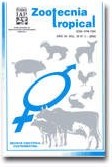
|
Zootecnia Tropical
Instituto Nacional de Investigaciones Agrícolas Venezuela
ISSN: 0798-7269
Vol. 28, No. 1, 2010, pp. 33-41
|
 Bioline Code: zt10005
Bioline Code: zt10005
Full paper language: English
Document type: Research Article
Document available free of charge
|
|
|
Zootecnia Tropical, Vol. 28, No. 1, 2010, pp. 33-41
| en |
Hydroponic forage production of corn ( Zea mays  L.) under natural conditions of light deficiency L.) under natural conditions of light deficiency
Rivera, Alvis; Moronta, María; González-Estopiñán, Mario; González, Diomary; Perdomo, Daniel; García, Danny E. & Hernández, Gustavo
Abstract
In order to evaluate the nutritive solution and cultivation methods in Corn ( Zea mays

L.), an experiment was
carried out in Trujillo state, Venezuela. hydroponic production under natural poor lighting conditions was
examined using a completely randomized block design with factorial arrangement 2 (nutritive solutions prepared
with commercial liquid fertilizer: Nitrofoska® (A) and Quimifol® (B) x 3 (cultivation methods: absorbent paper
(P), mesh (M), mesh with absorbent paper (MP) with six treatments and ten replicates. After the pre-germination
stage 0,13 m 2 plastic trays were used with 0,2 kg of seed equivalent. Yield, height, amount of absorbed solution
(CS), dry matter (DM) and crude protein (CP) percentage were measured. Significant interaction nutritive
solution x culture method for CP level was observed (P <0,05). Using P and MP (772 g/tray) and solution A (754
g/tray) the highest yield was obtained. No significant statistical differences in height (30,27 cm) with the method
and CS among treatments were observed (1377,0-1462,5 ml). The MS percentage showed little variation among treatments (16,30 -18,20). Using P method with B solution (18,13%) significant CP concentration was observed.
Under natural poor lighting conditions, the P method of cultivation was more efficient for yield and CP
concentration. Solution A was found to be the most appropriate according to the yield and height results.
|
| |
| es |
Producción de forraje verde hidropónico de maíz ( Zea mays  L.) en condiciones de iluminación deficiente L.) en condiciones de iluminación deficiente
Rivera, Alvis; Moronta, María; González-Estopiñán, Mario; González, Diomary; Perdomo, Daniel; García, Danny E. & Hernández, Gustavo
Resumen
Se llevó a cabo un experimento en el estado Trujillo, Venezuela, con el objetivo de evaluar el efecto de dos
soluciones nutritivas preparadas con fertilizante líquido comercial: Nitrofoska® (A) y Quimifol® (B) y tres
métodos de cultivo: papel absorbente (P), malla (M) y malla-papel (MP) en la producción de forraje verde
hidropónico de maíz, Zea mays

L., bajo condiciones de iluminación natural deficiente. Se empleó un diseño de
bloques al azar con arreglo factorial para seis tratamientos y 10 réplicas. Después de la etapa de pre-germinación
se usaron bandejas plásticas de 0,13 m 2 en las cuales se colocó el equivalente a 0,2 kg de semilla. Midiéndose el
rendimiento (R), altura (A), cantidad de solución absorbida (SC), porcentaje de materia seca (MS) y de proteína
bruta (PB). Solamente la PB presentó interacción significativa solución nutritiva x método de cultivo (P <0,05).
El mayor Rend se consiguió con P y MP (772 g/bandeja); así como con la solución A (754 g/bandeja). Con
la suatancia A se obtuvo la mayor A (30,27 cm), sin evidenciarse diferencias estadísticas respecto al método
(P >0,05). No se observaron discrepancias entre tratamientos en el consumo de solución (1.377,0-1.462,5 ml).
La MS no presentó diferencias significativas entre tratamientos (16,30-18,20 %) y la mayor concentración de
PB se logró cuando se usó P con la solución B (18,13 %). Los resultados permiten concluir que, en condiciones
de iluminación natural deficiente, el método P fue más eficiente para las variables R y PB. La solución A resultó
mejor en función del R y la A.
Palabras-clave
forraje, maíz, hidropónico, métodos de cultivo, soluciones nutritivas foliares
|
| |
© Copyright 2010 - Zootecnia Tropical
Alternative site location: http://www.sian.inia.gob.ve/repositorio/revistas_ci/ZootecniaTropical/ztindice.htm
|
|
